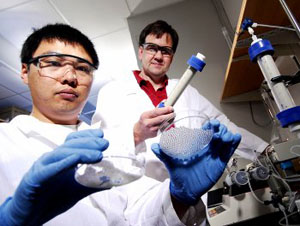What happens to carbon-based nanoparticles when they enter groundwater? Can municipal water supplies filter them out? And, if they cannot will they cause health problems? These are crucial questions that need answers now, as nanotechnology grows. Now, a new study by Kurt Pennell, of the Georgia Institute of Technology, and colleagues, suggests that subtle differences in the solution properties of the water carrying such particles can determine their ultimate fate.
Pennell and colleagues have studied the transportation of the archetypal nanoparticle, the soccerball-shaped carbon-60 molecule known as buckminsterfullerene, or the buckyball for short. While C60 is a well-studied molecule little is known about its environmental impact, moreover, little is known about what happens to this material and related materials, such as carbon nanotubes when they enter groundwater.

Kurt Pennell (standing) and Younggang Wang flush with success in water transport experiments on nanoparticles (Georgia Tech Photo: Gary Meek)
The researchers explain that in slightly salty water, clusters of C60 might aggregate and adhere tightly to soil particles or filtration system particles. However, in water contaminated with natural organic compounds or synthetic surfactants, such as detergents and soaps, isolated C60 particles would be stabilized and so be transported further in water.
In some cases, the nanoparticles move very little and you would get complete retention in the soil,” explains Pennell, But in different solution conditions or in the presence of a stabilizing agent, such as a surfactant, they can travel just like water. The movement of these nanoparticles is very sensitive to the solution conditions.

The buckyball, an archetypal nanoparticle
Pennell and his team have published detailed research funded by the US Environmental Protection Agency into the transport and retention of C60 nanoparticles in the journal Environmental Science and Technology.
We want to figure out now what will happen to these nanoparticles and how toxic they will be in the environment, says Pennell. The team hopes to build up a mechanistic model of what makes nanoparticles flow well in certain conditions and aggregate in others. When we look at real soils with finer particles, we will expect to see more retention, he says.
For municipal drinking water filtration, the sensitivity to solution characteristics means local conditions may play a key role. Under most conditions, you should be able to remove nanoparticles from the water, he adds, But you will have to be careful if the nanoparticles are stabilized by a natural surfactant or humic acid. If those are present in the water, the nanoparticles could go right through.
Further reading
Environ. Sci. Tech., 2008, in press
http://dx.doi.org/10.1021/es800128m
Dr. Kurt D. Pennell
http://people.ce.gatech.edu/~kp48/
Nanotech threat to your safety
https://www.sciencebase.com/science-blog/nanotech-threat-to-your-safety.html
Suggested searches
nanotechnology
fullerenes